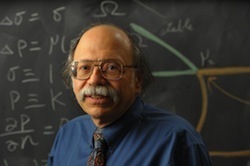
Andrew Sommese, professor in the Department of Applied and Computational Mathematics and Statistics, has received the 2010 Most Valuable Colleague Award from General Motors Research and Development for his work with Charles Wampler. Wampler, a GM senior researcher and adjunct professor in the department received the General Motors Research and Development prestigious Campbell Award. Sommese, the Vincent J. and Annamarie Micus Duncan Chair in Mathematics, and Wampler worked together for over a decade on numerical algebraic geometry and kinematics.
A large part of kinematics, which is a critical component of the design and improvement of machines ranging from windshield wipers and pistons to robot arms, reduces to questions about systems of polynomial equations, i.e., to questions about algebraic geometry. Starting in the mid–1990s, Sommese and Wampler devised a numerical approach for computing and manipulating the objects of algebraic geometry, i.e., the solution sets of systems of polynomial equations. The algorithms and methods developed in this research have greatly expanded the kinematics problems that can be solved which are very important in the further development and application of kinematics. Sommese and Wampler with two of Sommese’s former students, Daniel Bates of Colorado State University and Jonathan Hauenstein of Texas A & M University and the Mittag–Leffler Institute, developed a high performance computing software package, Bertini, to carry out numerical algebraic geometry computations.
Discretization of the systems of partial differential equations associated with many tumor growth models leads to polynomial systems with several orders of magnitude more equations and variables than the polynomial systems that arise in kinematics problems. Sommese is currently working with Bei Hu, professor of the Department of Applied and Computational Mathematics and Statistics, on numerical algebraic geometry algorithms to compute solutions and investigate questions of interest for models of the growth of cancer tumors.